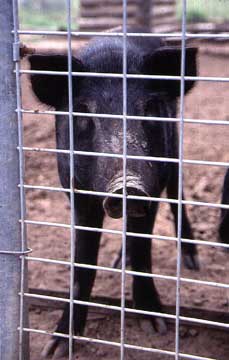 A number of methods and techniques are currently available for the control of feral animals, including fencing, trapping, shooting and poisoning. The type of control method chosen depends on the target species and the environmental surrounds. Successful long-term management of pest animals relies on cooperation with neighbours and the coordination of control activities. The effect of control techniques on non-target native species is an important consideration.
A number of methods and techniques are currently available for the control of feral animals, including fencing, trapping, shooting and poisoning. The type of control method chosen depends on the target species and the environmental surrounds. Successful long-term management of pest animals relies on cooperation with neighbours and the coordination of control activities. The effect of control techniques on non-target native species is an important consideration.
Current control methods include:
-
Chemical controls such as baiting, fumigation and spraying
-
Physical controls such as trapping, shooting, fencing and use of guard animals
-
Biological controls such as specific diseases
Some chemical and physical control techniques can be hazardous to people, stock and property, and current legislation enforces strict guidelines for their use. In choosing a control option, landowners may need to seek advice from their local government or the Department of Agriculture, Fisheries and Forestry.
You can find out all about control methods for pest animals on the Queensland Government website.
 Pig control in the Wet Tropics - an example
Pig control in the Wet Tropics - an example
The feral pig population in the Wet Tropics has been notoriously difficult to control. They are mobile, widely distributed and breed quickly. Pigs are responsible for ecological damage and are a major vector of weeds, pathogens and parasites. They cause economic damage to farms and crops. Many control methods have been attempted.
-
Poison baiting is regarded as the most effective method of quickly reducing feral pig numbers. However, available baits may still be taken by other species. With new methods and technologies, baiting has the potential to be an effective method of pig control in the region.
-
Trapping is becoming more effective and widely accepted. A pig specific gate trip mechanism has been developed to minimise the risk of trapping non-target native species such as cassowaries and wallabies. Various pig trapping programs in the Wet Tropics have caught thousands of pigs.
-
Shooting and hunting with dogs have been commonly used to control pigs. While they may be effective in dry seasons when pigs are congregated at available waterholes, there are strict controls over the use of firearms and dogs in protected areas and shooting is ineffective in rainforest areas and rugged terrain.
-
Fencing can be effective for small, critical areas. However, the most successful pig-proof fences are the most expensive and maintenance costs are high.
At present all these methods are capable of lowering pig numbers in local areas for a short time. However, they have failed to substantially lower pig numbers over time across the region. Any effective biological control is considered to be 10-20 years away. Researchers are now focusing on development of effective baits for feral pigs.
The Queensland Government website has detailed information about feral pig control.



 A number of methods and techniques are currently available for the control of feral animals, including fencing, trapping, shooting and poisoning. The type of control method chosen depends on the target species and the environmental surrounds. Successful long-term management of pest animals relies on cooperation with
A number of methods and techniques are currently available for the control of feral animals, including fencing, trapping, shooting and poisoning. The type of control method chosen depends on the target species and the environmental surrounds. Successful long-term management of pest animals relies on cooperation with  Pig control in the Wet Tropics - an example
Pig control in the Wet Tropics - an example